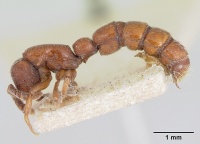Zasphinctus septentrionalis
| Zasphinctus septentrionalis | |
|---|---|

| |
| Scientific classification | |
| Kingdom: | Animalia |
| Phylum: | Arthropoda |
| Class: | Insecta |
| Order: | Hymenoptera |
| Family: | Formicidae |
| Subfamily: | Dorylinae |
| Genus: | Zasphinctus |
| Species: | Z. septentrionalis |
| Binomial name | |
| Zasphinctus septentrionalis (Crawley, 1925) | |
Identification
Distribution
Latitudinal Distribution Pattern
Latitudinal Range: -12.44999981° to -12.46153°.
| North Temperate |
North Subtropical |
Tropical | South Subtropical |
South Temperate |
- Source: AntMaps
Distribution based on Regional Taxon Lists
Australasian Region: Australia (type locality).
Distribution based on AntMaps
Distribution based on AntWeb specimens
Check data from AntWeb
Countries Occupied
| Number of countries occupied by this species based on AntWiki Regional Taxon Lists. In general, fewer countries occupied indicates a narrower range, while more countries indicates a more widespread species. |

|
Estimated Abundance
| Relative abundance based on number of AntMaps records per species (this species within the purple bar). Fewer records (to the left) indicates a less abundant/encountered species while more records (to the right) indicates more abundant/encountered species. |

|
Biology
Castes
Nomenclature
The following information is derived from Barry Bolton's Online Catalogue of the Ants of the World.
- septentrionalis. Eusphinctus (Nothosphinctus) septentrionalis Crawley, 1925b: 577 (w.) AUSTRALIA (Northern Territory).
- Type-material: syntype workers (number not stated).
- Type-locality: Australia: Northern Territory, Darwin, no.567 (Hill).
- Type-depositories: BMNH, OXUM.
- Combination in Sphinctomyrmex: Brown, 1975: 33;
- combination in Zasphinctus: Borowiec, M.L. 2016: 243.
- Status as species: Brown, 1975: 33; Taylor & Brown, 1985: 51; Taylor, 1987a: 73; Bolton, 1995b: 392.
- Distribution: Australia.
Type Material
- Syntype, worker(s), Darwin, Northern Territory, Australia, The Natural History Museum.
- Syntype, 1 worker, Darwin, Northern Territory, Australia, Museum of Comparative Zoology.
- Syntype, worker(s), Darwin, Northern Territory, Australia, Oxford University Museum of Natural History.
Unless otherwise noted the text for the remainder of this section is reported from the publication that includes the original description.
Description
Worker
Length 52 mm.
Castaneous; head slightly darker, legs paler, mandibles and clypeus considerably darker; margination of head, pronotum, and epinotum darker than the mandibles; gastric segments with dark rims.
Body, including legs and antenme, with a fine yellow pilosity, less abundant on thorax. Funiculi pubescent.
Head very slightly longer than broad, a fraction broader in front, the sides almost straight, contracting feebly in the middle, occiput widely and shallowly emarginate and subtruncate, the border marginate. Mandibles not very strongly bent at base, minutely and indistinctly denticulate, but in the centre of the terminal border is a longer and sharp tooth. Carinae on cheeks fairly developed. Frontal carinae seen from the front, widest anteriorly, then becoming almost parallel, nearly four times as long as wide behind; in front they encircle the antennal insertions, behind they are concavely truncate but not absolutely fused; at their extremity they join a finely impressed line which runs up the front. Eyes and ocelli absent. Scapes extend for almost two-thirds of the distance from their bases to the occiput; they are not quite twice as broad at the apex as at the base. All funicular joints except the apical broader than long, 2 to 6 very gradually increasing in size, 7 to 10 more rapidly; the apical joint is rather longer than the preceding two taken together, but less than the preceding three.
Thorax twice as long as broad, feebly contracted at the sides between the meso- and epinotum, with an indication of a suture above. Pronotum a shade broader than epinotum. Declivity entirely marginate.
Petiole slightly broader than long, a shade broader behind, the sides convex; nearly three-quarters as broad as the postpetiole, which is broader than long and a little more than three-quarters as broad in front as behind, feebly convex above; the following segment shorter and broader, the next slightly shorter but as broad, the next as long but slightly narrower.
Mandibles shining, coarsely punctate only, no trace of striation. The whole of the upper surface of head, except the ocellar region, densely and coarsely punctate. There is a faint ground-striation in front, otherwise the surface is shining. The punctures are most abundant and largest on the anterior half. At the sides they become closely massed together and are connected by reticulations. On the occipital truncation the punctures are shallow. Each puncture on the upper surface of head has a microscopical central eminence bearing a hair.
Dorsum of thorax shining, sparsely punctate, the punctures smaller than those on the head. Down the centre there is a strip almost free of punctures except for a large one at the junction of meso- and epinotum. Sides with small sparse punctures and indications of a ground-reticulation. Declivity shining with a faint microscopical reticulation. Petiole punctured similarly to the head, also the postpetiole and following segments of gaster, the punctures becoming more superficial and smaller as the apex is approached. Legs and antennae closely punctate, the funiculus very minutely so.
References
- Borowiec, M.L. 2016. Generic revision of the ant subfamily Dorylinae (Hymenoptera, Formicidae). ZooKeys 608: 1-280 (doi:10.3897/zookeys.608.9427).
- Brown, W. L., Jr. 1975. Contributions toward a reclassification of the Formicidae. V. Ponerinae, tribes Platythyreini, Cerapachyini, Cylindromyrmecini, Acanthostichini, and Aenictogitini. Search Agric. (Ithaca N. Y.) 5(1 1: 1-115 (page 33, Combination in Sphinctomyrmex)
- Crawley, W. C. 1925b. New ants from Australia. - II. Ann. Mag. Nat. Hist. 9(16): 577-598. (page 577, worker described)
References based on Global Ant Biodiversity Informatics
- Taylor R. W. 1987. A checklist of the ants of Australia, New Caledonia and New Zealand (Hymenoptera: Formicidae). CSIRO (Commonwealth Scientific and Industrial Research Organization) Division of Entomology Report 41: 1-92.

